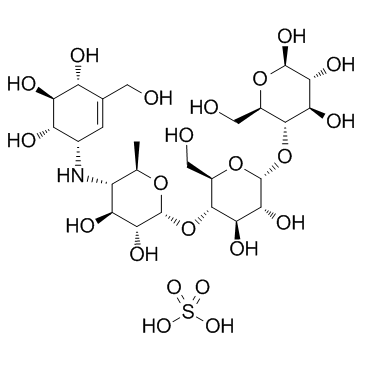| Description |
Acarbose sulfate is an inhibitor of alpha glucosidase, an anti-diabetic drug.
|
| Related Catalog |
|
| In Vitro |
Acarbose (1, 2, and 3 μM) dose- and time-dependently inhibits TNF-α-induced VSMC proliferation and migration. Acarbose (1, 2, and 3 μM) dose-dependently decreases β-galactosidase, Ras expression and increased p-AMPK expression in TNF-α pre-treated A7r5 cells[2].
|
| In Vivo |
Acarbose (300 mg/60 kg body weight) decreases the fasting blood glucose, and regulates the glucose tolerance of DM rats without body weight loss. Acarbose significantly suppresses serum IL6 and TNF-α in DM rats[1]. Acarbose (2.5 and 5.0 mg/kg) significantly and dose-dependently decreases the intensity of neointimal IL-6, TNF-α, and iNOS staining, and significantly increases the intensity of neointimal p-AMPK staining. Acarbose (2.5 and 5.0 mg/kg) significantly and dose-dependently decreases neointimal Ras and β-galactosidase expression in HCD-fed rabbits without body weight loss[2].
|
| Cell Assay |
Cell viability is determined using the MTT assay. Cells are seeded in 24-well culture plates at a density of 2×104 cells/well, incubated for 48 h, treated with acarbose at varying concentrations (0.5, 1.0, 2.0, 3.0, and 5.0 μM) for 24 h; or pre-treated with TNF-α (20 ng/mL) for either 24 h or 48 h to evaluate the dose-dependent effects of acarbose on VSMC growth and viability, cultured with 0.5 mg/mL MTT at 37°C in a humidified atmosphere of 5% CO2 for another 4 h, and solubilized with isopropanol. The viable cell number varies directly with the concentration of formazan product measured spectrophotometrically at 563 nm.
|
| Animal Admin |
Twenty-four male New Zealand white rabbits, weighing 2500 g are used. They are individually housed in metal cages in an air-conditioned room (22 ± 2°C, 55 ± 5% humidity), under a 12 h light/12 h dark cycle with free access to food and water. All rabbits are randomLy assigned to four groups of 6 animals each and are fed either standard chow (Group I), high cholesterol diet (HCD; containing 95.7% standard Purina chow + 3% lard oil + 0.5% cholesterol) (Group II), HCD diet and 2.5 mg/kg per day acarbose (Group III), or HCD diet and 5.0 mg/kg per day acarbose (Group IV). At the end of the 25 weeks, all rabbits are sacrificed by exsanguination under deep anesthesia with pentobarbital (30 mg/kg i.v.) injected via the marginal ear vein. Serum is stored at −80°C prior to measurement of serum values. The aortic arch and thoracic aortas are carefully removed to protect the endothelial lining, and are collected and freed of adhering soft tissue.
|
| References |
[1]. Zhang Q, et al. Acarbose Reduces Blood Glucose by Activating miR-10a-5p and miR-664 in Diabetic Rats. PLoS One. 2013 Nov 18;8(11):e79697. [2]. Chan KC, et al. Pleiotropic effects of acarbose on atherosclerosis development in rabbits are mediated via upregulating AMPK signals. Sci Rep. 2016 Dec 7;6:38642
|
